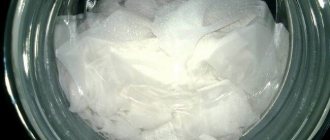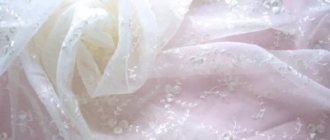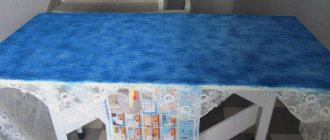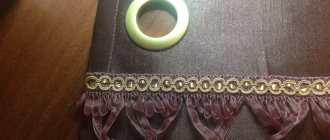Despite the availability of a huge number of window design options, classic white tulle remains the favorite of most housewives.
The material, which allows you to benefit from the opening and make the room spacious and bright, unfortunately has a “capricious” character and over time noticeably changes its color to pale yellow or grayish even in a perfectly clean room.
However, knowing several ways to bleach tulle at home, you can safely turn a blind eye to this small drawback!
In this article, we tried to collect all the effective methods, including those proven over decades and known to our grandmothers.
Bleaching with table salt
What to cook?
- 3-5 tablespoons of table salt (the most common - coarse);
- washing powder (not necessarily bleaching);
- pelvis
What to do?
- 1 Dissolve the salt and powder in warm water and immerse the tulle that has lost its whiteness in the resulting solution.
- 2 Leave it to soak for at least 3-4 hours (ideally overnight).
- 3 For heavy soiling, machine wash the fabric; for light soiling, simply rinse well.
- 4 For “prevention”, washed tulle can be rinsed in a saline solution after washing for several minutes.
Pros and cons of the method
- High-quality whitening will cost you a few rubles.
- You don’t have to look for salt specifically – it’s in every kitchen.
- This method can be used to wash children's curtains - salt is not an allergen.
- Salt bleaching will take several hours.
How to bleach tulle in a washing machine without soaking
If you don’t have time to soak, and the material from which the tulle is made can be delicately machine washed, use the following method.
Add 1 tbsp to the washing powder compartment. l. soda, 1 tbsp. l. coarse table salt and 1 packet of baking powder. Pour 1 tbsp into the conditioner compartment. l. vinegar and wash the tulle on a delicate cycle without spinning. Do not load tulle into the washing machine drum without additional protection: place the neatly folded fabric in a special washing bag or use a pillowcase.
Before you start bleaching or washing, carefully fold the tulle. If you soak or load crumpled fabric into the drum of the washing machine, it will leave creases that are difficult to smooth out.
Blue bleaching
What to cook?
- Blue;
- pre-washed tulle.
What to do?
- 1 Wash by hand. Dilute half a teaspoon of blue in 7-10 liters of warm water, make sure that there are no “lumps” in the solution (they can leave stains on the fabric). Rinse the tulle thoroughly, first with blue, and then in clean water.
- 2 Washing in an automatic machine. Place the material in the drum and add your regular laundry detergent. Instead of conditioner or rinse aid, use blue in small quantities (1-1.5 caps).
Pros and cons of the method
- The whitening process does not take much time.
- As a result, the tulle becomes truly snow-white.
- Finding bluing in supermarkets or chain stores of household chemicals today is almost impossible - the search for “bleach” can take a long time.
- If you don't mix the powder thoroughly enough, difficult-to-remove stains will remain on the fabric. It is for this reason that it is better to rinse blue tulle manually - some machines “sin” by insufficiently dissolving the bleaching agent (whole pieces can get directly into the drum).
How can you bleach organza?
Organza tulle is a particularly delicate material that cannot be treated with all bleaching agents. When working with it, you can use blue, a solution of peroxide with ammonia, brilliant green, and also a saline solution. Such products can only be soaked in water at a temperature no higher than 40 degrees; moreover, it is strictly forbidden to twist them, as they can become deformed and even tear under such influence.
Important: it is forbidden to wash organza products in hot water, much less boil them. Also, to clean such products, you cannot use bleach sold in household chemical departments. Such products can hopelessly damage delicate fabric.
Bleaching with brilliant green
What to cook?
- Zelenka;
- cup;
- pelvis
What to do?
- Stir 5-10 drops of greenery in a glass of warm water and leave it for a few minutes.
- Evaluate the result - if you do not see any sediment, the solution is ready and can be poured into a basin for rinsing (7-10 liters of warm water).
- If there is still sediment, mix the contents of the glass well again or strain it before “sending” it into the basin.
Place the tulle, previously washed in the usual way (by hand or in a machine), in a basin with a solution of brilliant green and leave there for 3-5 minutes, turning the material over a couple of times. Hang the curtain and let it drain.
Pros and cons of the method
- Zelenka is in every home medicine cabinet.
- Brilliant green solution is very cheap compared to household chemicals.
- Returning the color to tulle takes a minimum of time.
- If you do not mix the greenery well enough, the material will not acquire a snow-white hue, but light green stains, which are quite problematic to remove.
Useful tips
Do not use chemicals unless absolutely necessary. And the use of chlorine is generally contraindicated. Give preference to oxygen gels. Always consider fabric composition when intending to manipulate tissue.
Rules for washing tulle made of delicate and light fabrics:
- Mechanical cleaning. There can be no question of it if the composition of the tulle is delicate: no brushes, abrasives or powders. A cleaning method that involves rubbing fabric against fabric is also discarded - it is fraught with stretching and deformation of the delicate fabric.
- Squeeze and tap. You only need to wash the tulle with light squeezes and pats of the dirty area. If the localized stain problem is not neutralized the first time, the solution used for soaking and washing is changed and the washing is repeated.
Regardless of the composition and method, before washing the tulle, it must be cleaned. It consists of getting rid of large accumulations of dust. It is convenient to carry out the procedure outdoors - just shake the curtain several times.
Under no circumstances should you use brushes or abrasives - this can lead to the formation of abrasions, permanent yellowness, pellets and even holes.
How to dry properly
To avoid fabric deformation, twisting and wringing are kept to a minimum. It is ideal to let the water drain on its own - to do this, the tulle should be hung on a rope.
Drying should be done away from heating devices. Avoid direct sunlight.
When water stops dripping from the curtains, they can be returned to their usual place - on the curtains. Thin tulle will not only dry, but also smooth out, without requiring ironing.
Ironing rules
Almost all tulle, except cotton, cannot be ironed. To avoid the need for an iron, dry properly.
If the process cannot be avoided, use low temperatures, use a cloth (for example, gauze) to iron on it, and not on the fabric of the curtain itself. Iron in “Silk” mode.
Despite the prejudice: the more you wash, the cleaner the tulle will be - frequent washing will inevitably lead to the loss of its attractive appearance. This is a sure way to damage the fabric, which is difficult or even impossible to neutralize. Therefore, wash your tulle no more than four times a year, but do it correctly.
Whitening with ammonia and hydrogen peroxide
What to cook?
- Ammonia;
- 3% hydrogen peroxide.
What to do?
- 1 Add 1 spoon of alcohol and 2-3 spoons of peroxide to a bowl of water heated to 60 degrees, mix the solution well.
- 2 Dip the tulle in it for half an hour.
- 3 After this time, rinse the fabric well, wring it out without twisting, and hang it to dry.
Pros and cons of the method
- Cheap: one whitening treatment costs less than 10 rubles and still gives excellent results.
- You will spend a minimum of time on washing - no overnight soaking is required.
- This method should only be used for bleaching cotton materials.
How to bleach old tulle
It is quite difficult to restore the whiteness of old fabric; often 1-2 bleaching methods are not enough and an integrated approach is required. Use the following scheme:
- wash the tulle as usual;
- use the boiling method (if the fabric allows);
- soak the tulle in hydrogen peroxide and ammonia;
- rinse in a strong saline solution;
- fix the result by rinsing in starch.
For old stains, use an integrated approach
Whiteness with starch
What to cook?
- Starch;
- large container (basin or bucket).
What to do?
- 1 Clean the tulle from dust, and if it is heavily soiled, wash it in the machine as usual.
- 2 Place the prepared material in a bowl of warm water, in which 250 grams of ordinary starch have been thoroughly mixed.
- 3 Leave the curtains in the solution for 5-6 hours, then hang them without wringing them out.
Pros and cons of the method
- Minimum cost of whitening
- Starch can be found in any store.
- The tulle will not only become snow-white, but will also keep its shape well.
- You'll have to spend several hours.
How to clean a nylon product
Nylon is considered a very delicate material that can be spoiled by choosing the wrong washing mode or the wrong bleaching products. Products made from it are strictly prohibited from being washed in hot water. It is recommended to rinse them by hand or machine wash them on a gentle cycle.
How to bleach nylon tulle? For this purpose, you can use products such as brilliant green or blue. Potassium permanganate or saline solution works well with this material. If you also want such a curtain to keep its shape as best as possible after washing and bleaching, be sure to treat it with starch - it will help keep your product beautiful in shape and looking fresh.
Bleaching with potassium permanganate
What to cook?
- Potassium permanganate;
- laundry soap (72 percent);
- pelvis;
- cup;
- grater
What to do?
- 1 Finely grate 100 grams of soap and stir the resulting mass in warm water.
- 2 Dissolve a small amount of potassium permanganate in a glass of water, make sure there is no sediment and pour the resulting solution into a basin. The result should be slightly pinkish water with a small amount of soap suds.
- 3 Soak the tulle in the basin for half an hour and wash it in the usual way (by hand or in a washing machine).
Pros and cons of the method
- Excellent results that last quite a long time.
- Minimum time spent.
- Finding potassium permanganate today is quite difficult.
Digestion
What to cook?
- Bucket or large saucepan;
- washing powder or laundry soap.
What to do?
- 1 Dissolve powder or soap in water, put tulle in a container and put it on the fire.
- 2 Wait until the water boils and simmer the fabric for an hour, stirring occasionally.
Pros and cons of the method
- Cheapness.
- The method requires constant presence nearby.
- The method is quite inconvenient and really outdated - we recommend boiling tulle only when dealing with yellowness, which has not been “taken” by other washing methods.
Are whitening and modern bleaches effective?
It is not for nothing that we did not mention in the main material about traditional whiteness and modern bleaches, which, according to manufacturers, use innovative formulas.
Undoubtedly, the listed means give excellent results and, importantly, do not require a lot of time to achieve them. As a matter of fact, this is where their advantages end.
Whiteness literally “destroys” the fabric and after 2-3 uses, thin tulle can tear from any careless movement.
In addition, after the second wash with white, the material does not acquire a snow-white tint, but a shade close to yellow.
The same applies to innovative products: having a considerable cost, they give excellent results only the first time they are used.
Causes of pollution
The appearance of the product deteriorates under the influence of certain factors.
- Dust and dirt - dust particles in the apartment, exhaust gases and sand from the street - all this settles on the window drapery and gives it a gray tint.
- The sun - due to active rays, the canvas acquires a yellow tint.
- Touching and other human factors - when we pull back the curtain, we leave a trace on it, albeit invisible to the naked eye. Gradually, an unsightly stain forms in this place. In the kitchen, drops of fat are added to this. The situation is even more complicated in a house where there are children: there is a possibility that paints, felt-tip pens, plasticine and other difficult-to-remove contaminants will get on the canvas.
Additional recommendations
- 1 Be sure to shake out the tulle before soaking.
- 2 In all cases (except where indicated), do not use too hot water: a temperature of 30-35 ⁰C is optimal. Washing in boiling water will “seal” stains and yellowness rather than remove them.
- 3 Wash and soak the tulle, after carefully folding it. If you throw crumpled material into the basin or drum of the machine, the resulting creases will be very difficult to smooth out.
- 4 When washing, add a tablespoon of table vinegar to the water - the smell will not appear from such an amount, and the curtains will shine in the sun.
- 5 Do not iron the tulle after washing - gently wring it out (without twisting!) and let it drain. Damp curtains can be hung on a curtain rod - they will straighten under their own weight.
The tips listed above on how to bleach tulle at home have passed the most important test - the test of time. You can safely follow these recommendations without fear of harming thin and delicate material.
Household chemicals
Nowadays there are many means that allow you to bleach any type of fabric in a washing machine or by hand washing without any effort. Such bleaches are “Ace”, “Vanish” and others. Depending on the manufacturers' recommendations, these products should be added to the powder during machine washing or the items should be soaked directly in them. Such tools have several advantages:
- they quickly deal with stains;
- are easier to use than “grandmother’s” methods and require less time;
- allow you to deal with any stains, even old ones, in just one wash.
They also have their disadvantages. These include the pungent odor of many compounds (for example, “Whiteness”), as well as a negative effect on the fabric, due to which it begins to crumble after the third such wash. In addition, they can cause allergies in humans and are completely unsuitable for those housewives who suffer from bronchial asthma. If you encounter similar problems when using such products, you should use folk remedies, thanks to which even gray tulle with red spots can return to its original appearance.











